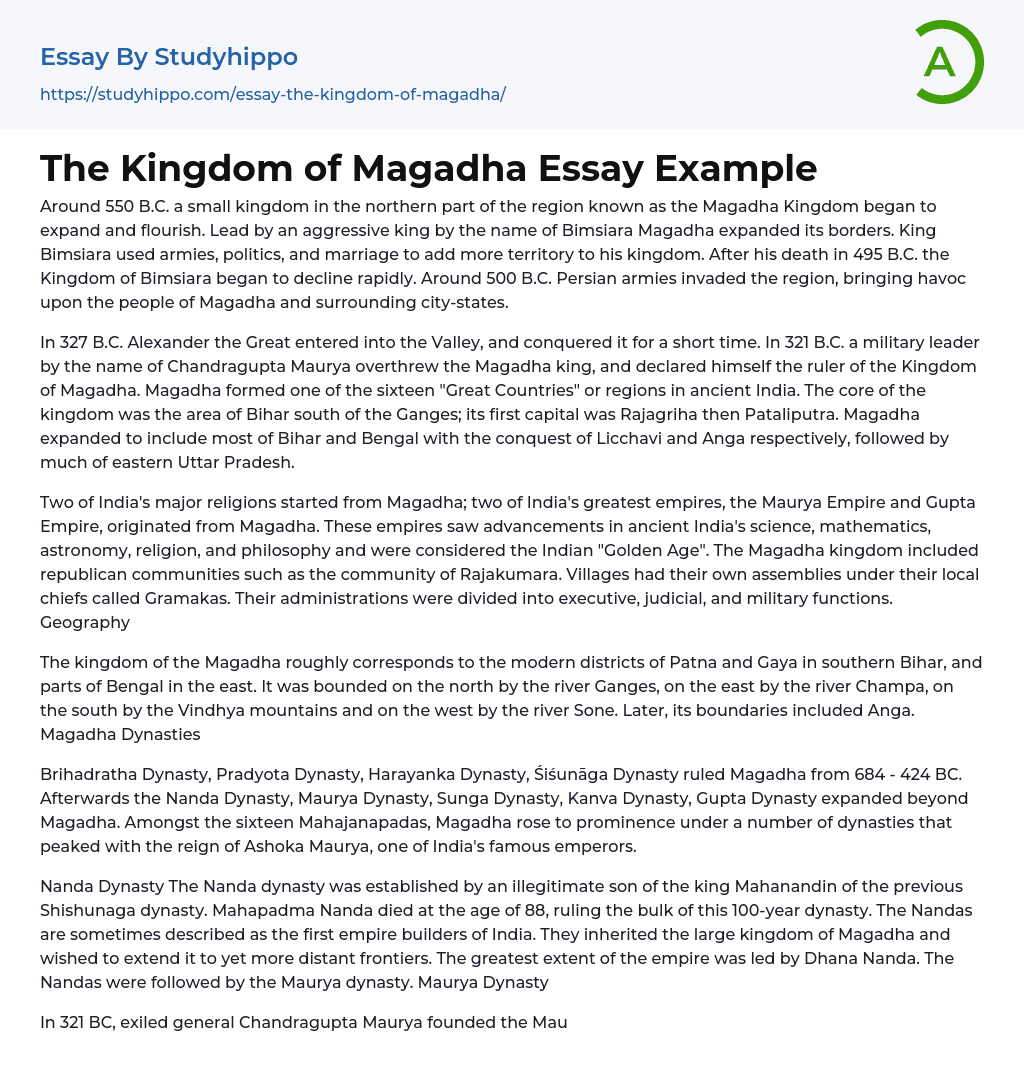Around 550 B.C. a small kingdom in the northern part of the region known as the Magadha Kingdom began to expand and flourish. Lead by an aggressive king by the name of Bimsiara Magadha expanded its borders. King Bimsiara used armies, politics, and marriage to add more territory to his kingdom. After his death in 495 B.C. the Kingdom of Bimsiara began to decline rapidly. Around 500 B.C. Persian armies invaded the region, bringing havoc upon the people of Magadha and surrounding city-states.
In 327 B.C. Alexander the Great entered into the Valley, and conquered it for a short time. In 321 B.C. a military leader by the name of Chandragupta Maurya overthrew the Magadha king, and declared himself the ruler of the Kingdom of Magadha. Magadha formed one of the sixteen "Great Countries" or regions in ancient India. The core of the kingdom was the area
...of Bihar south of the Ganges; its first capital was Rajagriha then Pataliputra. Magadha expanded to include most of Bihar and Bengal with the conquest of Licchavi and Anga respectively, followed by much of eastern Uttar Pradesh.
Two of India's major religions started from Magadha; two of India's greatest empires, the Maurya Empire and Gupta Empire, originated from Magadha. These empires saw advancements in ancient India's science, mathematics, astronomy, religion, and philosophy and were considered the Indian "Golden Age". The Magadha kingdom included republican communities such as the community of Rajakumara. Villages had their own assemblies under their local chiefs called Gramakas. Their administrations were divided into executive, judicial, and military functions. Geography
The kingdom of the Magadha roughly corresponds to the modern
districts of Patna and Gaya in southern Bihar, and parts of Bengal in the east. It was bounded on the north by the river Ganges, on the east by the river Champa, on the south by the Vindhya mountains and on the west by the river Sone. Later, its boundaries included Anga. Magadha Dynasties
Brihadratha Dynasty, Pradyota Dynasty, Harayanka Dynasty, Śiśunāga Dynasty ruled Magadha from 684 - 424 BC. Afterwards the Nanda Dynasty, Maurya Dynasty, Sunga Dynasty, Kanva Dynasty, Gupta Dynasty expanded beyond Magadha. Amongst the sixteen Mahajanapadas, Magadha rose to prominence under a number of dynasties that peaked with the reign of Ashoka Maurya, one of India's famous emperors.
Nanda Dynasty The Nanda dynasty was established by an illegitimate son of the king Mahanandin of the previous Shishunaga dynasty. Mahapadma Nanda died at the age of 88, ruling the bulk of this 100-year dynasty. The Nandas are sometimes described as the first empire builders of India. They inherited the large kingdom of Magadha and wished to extend it to yet more distant frontiers. The greatest extent of the empire was led by Dhana Nanda. The Nandas were followed by the Maurya dynasty. Maurya Dynasty
In 321 BC, exiled general Chandragupta Maurya founded the Maurya dynasty after overthrowing the reigning Nanda king Dhana Nanda to establish the Maurya Empire. The kingdom was inherited by his son Ashoka. He initially sought to expand his kingdom. Maurya was a skilled leader and politician, as well as military leader. He expanded the Kingdom of Magadha into the Mauryan Empire. Maurya developed infrastructure such as roads, bridges, and a post office, that would help his empire
to flourish for almost 150 years.
- Mahayana essays
- Russian Empire essays
- Ancient Greece essays
- British Empire essays
- Historical Figures essays
- Nazi Germany essays
- Roman Empire essays
- War essays
- Revolution essays
- 19Th Century essays
- Historiography essays
- History of the United States essays
- 20Th Century essays
- World History essays
- Vikings essays
- Declaration of Independence essays
- Civilization essays
- Evidence essays
- Genocide essays
- Colonialism essays
- Rebellion essays
- 1960S essays
- 1920S essays
- 1950S essays
- Letter from Birmingham Jail essays
- Louisiana Purchase essays
- The Columbian Exchange essays
- World Hunger essays
- What is History essays
- Bravery essays
- Gilded Age essays
- Vladimir Lenin essays
- Alexander The Great essays
- Sparta essays
- Victorian Era essays
- Henry v essays
- Stonehenge essays
- Frederick Douglass essays
- Mahatma Gandhi essays
- Joseph Stalin essays
- Geert Hofstede essays
- George Eliot essays
- Ginevra King essays
- John Keats essays
- Siegfried Sassoon essays
- Ben jonson essays
- Billy elliot essays
- Wilkie collins essays
- John Proctor essays
- Harriet Tubman essays




